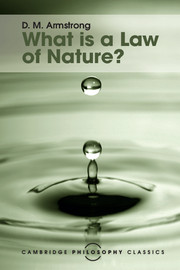Book contents
- Frontmatter
- Dedication
- Contents
- Preface to this edition
- Acknowledgements
- Part I A critique of the Regularity theory
- 1 Introductory
- 2 Critique of the Regularity theory (1): The problem of accidental uniformities
- 3 Critique of the Regularity theory (2)
- 4 Critique of the Regularity theory (3)
- 5 Can the Regularity theory be sophisticated?
- Part II Laws of nature as relations between universals
- Conclusions
- Works cited
- Index
4 - Critique of the Regularity theory (3)
from Part I - A critique of the Regularity theory
Published online by Cambridge University Press: 05 July 2016
- Frontmatter
- Dedication
- Contents
- Preface to this edition
- Acknowledgements
- Part I A critique of the Regularity theory
- 1 Introductory
- 2 Critique of the Regularity theory (1): The problem of accidental uniformities
- 3 Critique of the Regularity theory (2)
- 4 Critique of the Regularity theory (3)
- 5 Can the Regularity theory be sophisticated?
- Part II Laws of nature as relations between universals
- Conclusions
- Works cited
- Index
Summary
It was argued in Chapter 2 that there are innumerable Humean uniformities which we think are neither laws of nature nor manifestations of such laws. In Chapter 3 it was argued that there are, or can be, laws of nature which are not manifested in Humean uniformities. It was also pointed out that in the case of probabilistic and functional laws the relation between the content of a law and the content of the manifestation of the law need not be identity, yet identity is demanded by the Regularity theory.
In this chapter, all these difficulties will be waived. Suppose it to be a law of nature that Fs are Gs, and that this law issues in the (actually instantiated) uniformity that each F is a G. Even given this favourable case for the Regularity theorist, there are great difficulties in identifying the law and the uniformity.
Lack of inner connection
Suppose it to be a law that Fs are Gs, and suppose there to be a plurality of Fs. Consider one of these: a. By hypothesis, it is a G. We can say that a's being F nomically necessitates a's being G.
Suppose, however, that we consider this particular instance falling under the law from the standpoint of the Regularity theory. What does the theory postulate to obtain? Nothing but the two states of affairs: a's being F, and a's being G. Yet such a mere conjunction of states of affairs can obtain where there is absolutely no nomic connection between the states of affairs involved. For the Regularity theory, the essence of the nomic connection is not to be found in the two states of affairs and any dyadic relation which holds just between them. Rather, a's being F nomically necessitates a's being G only because the other Fs are also all of them Gs. That the conjunction of states of affairs is a case of nomic necessitation is a purely relational property of the conjunction.
The objection to the Regularity theory is that this seems not enough. We think that if a's being F is nomically to necessitate a's being G, then at least part of what must exist is some direct, dyadic relation holding between the two particular states of affairs.
- Type
- Chapter
- Information
- What is a Law of Nature? , pp. 36 - 55Publisher: Cambridge University PressPrint publication year: 2016



